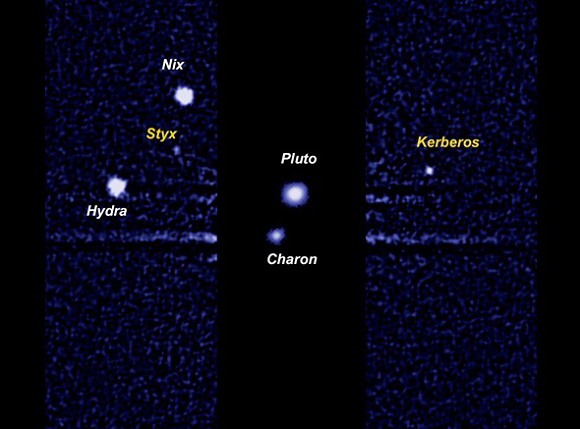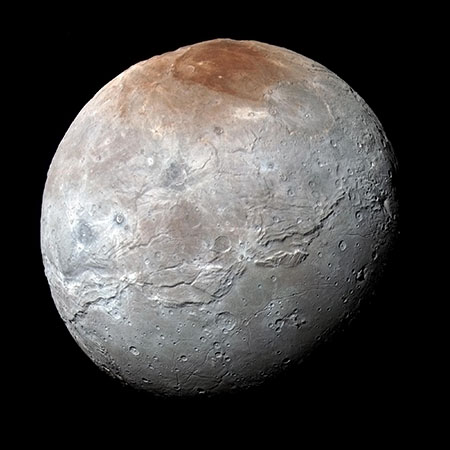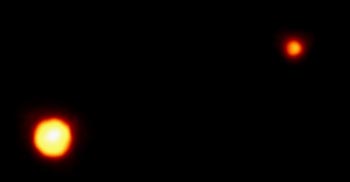Charon
It really may be more accurate to call Pluto and Charon a double-planet system. At about 1,186 km (737 miles), Charon's diameter is a little more than half of Pluto's. No other planetary moon in our solar system is so close in size to its planet.
The duo are also our solar system's only planet and moon whose gravity has locked them into a mutually synchronous orbit, which keeps each one facing the other with the same side. Many moons - including our own - keep the same hemisphere facing their planet. But this is the only case in which the planet always presents the same hemisphere to its moon. If you stood on one and watched the other, it would appear to hover in place, never moving across the sky.
In Greek mythology, Charon was the boatman who carried the souls of the dead to the underworld - a kingdom that in Roman mythology was ruled by the god, Pluto. The U.S. Naval Observatory's James Christy suggested the name after he found the moon in 1978.
Seven years later, Charon and Pluto began a five-year period of eclipsing each other from Earth's point of view. That was lucky for us, because it enabled scientists to measure the diameters and masses of both objects as each passed in front of the other.
Charon appears to be covered by water ice, which differs from Pluto's surface of frozen nitrogen, methane, and carbon dioxide. One theory is that the materials that formed Charon were blasted out of Pluto in a collision. That's very similar to the way in which our own moon is thought to have been created.
NASA launched its New Horizons spacecraft to Pluto and Charon in January 2006, and it should arrive in 2015, becoming the first spacecraft to visit them. In preparation, the New Horizons project is organizing a search for additional moons of Pluto, using ground-based telescopes and possibly the Hubble Space Telescope.
| Charon data |
| Discovery by |
James Christy |
| Discovery year |
1978 |
| Mean distance from Pluto |
19,600 km |
| Diameter |
1,186 km |
| Mass |
1.62 x 10²¹ kg |
| Escape velocity |
0.61 km/s |
| Orbital period |
6.4 days |
| Axial period |
6.4 days |
| Orbital inclination |
96.16° |
| Albedo |
0.5 |
| Surface temperature |
-240 °C |
Nix
Nix is the inner of the two moons discovered orbiting Pluto in 2005. Nix and Hydra are roughly 5,000 times fainter than Pluto and are about two to three times farther from Pluto than its large moon, Charon, which was discovered in 1978. Nix and Hydra are roughly 20 to 70 miles (32 to 113 km) wide.
Nix was discovered in June, 2005 by Hal Weaver and a large team of astronomers using the Hubble Space Telescope.
Hydra
Hydra is the outer of the two moons discovered orbiting Pluto in 2005. Same as Nix, Hydra is not bigger than 113 km wide, 5,000 times fainter than Pluto and is about two to three times farther from Pluto than Charon.
Hydra was discovered in June, 2005 by Hal Weaver and a large team of astronomers using the Hubble Space Telescope.
Kerberos
Astronomers using the Hubble Space Telescope discovered a fourth moon orbiting the icy dwarf planet Pluto in 2011 while searching for rings around the dwarf planet. The moon was temporarily designated S/2011 (134340) 1 (and sometimes called P4) and was officially named Kerberos by the International Astronomical Union (IAU) in 2013.
Kerberos has an estimated diameter of 8 to 21 miles (13 to 34 km). By comparison, Charon, Pluto's largest moon, is 648 miles (1,043 km) across, and two other moons of Pluto, Nix and Hydra, are in the range of 20 to 70 miles in diameter (32 to 113 km).
The discovery of Kerberos was the result of ongoing work to support NASA's New Horizons mission, scheduled to fly through the Pluto system in 2015. The mission is designed to provide new insights about worlds at the edge of our solar system. Hubble's mapping of Pluto's surface and discovery of its satellites have been invaluable to planning for New Horizons' close encounter.
Styx
Astronomers using the Hubble Space Telescope discovered icy dwarf planet Pluto's fifth moon in 2012. In 2013, the International Astronomical Union (IAU) named the tiny satellite Styx. Styx was uncovered in a Hubble survey searching for potential hazards for the 2015 New Horizons spacecraft flyby of Pluto.
The moon is estimated to be 6 to 15 miles across. It is in a 58,000-mile-diameter circular orbit around Pluto that is assumed to be co-planar with the other satellites in the system.
Styx was discovered on 26 June 2012 by a large team led by Mark Showalter using the Hubble Space Telescope.

A Hubble Space Telescope image of Pluto and its moons. Charon is the largest moon close to Pluto. The other four bright dots are smaller moons discovered in 2005, 2011 and 2012. These moons are so small and so faint that the astronomers mixed two photos, one under exposed with Pluto and Charon, and other over exposed with the tiny four moons. That’s way these moons are in a vertical blue stripes, and Pluto and Charon have black background.
Photo: NASA
Information from: SSE-JPL-NASA and David Darling's encyclopedia



